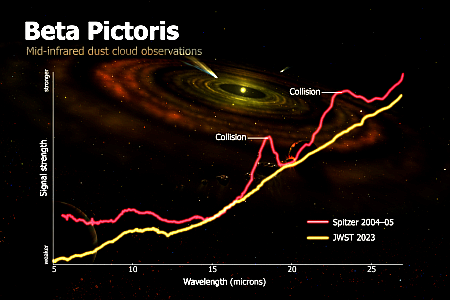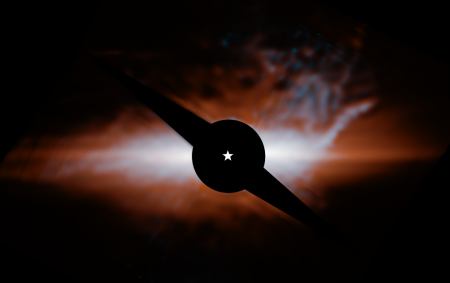Evidence of giant asteroid collision in debris disk surrounding the star Beta Pictoris
Scientists comparing infrared data collected twenty years apart — first by the Spitzer Space Telescope and then by the Webb Space Telescope — think they have detected evidence of a gigantic asteroid collision in the debris disk that surrounds the very young star Beta Pictoris, located 63 light years away.
The graph to the right shows the change found between the observations. From the caption:
Scientists theorize that the massive amount of dust seen in the 2004–05 image from the Spitzer Space Telescope indicates a collision of asteroids that had largely cleared by the time the James Webb Space Telescope captured its images in 2023.
…When Spitzer collected the earlier data, scientists assumed something like small bodies grinding down would stir and replenish the dust steadily over time. But Webb’s new observations show the dust disappeared and was not replaced. The amount of dust kicked up is about 100,000 times the size of the asteroid that killed the dinosaurs, Chen said.
It is believed by scientists that the debris disk that surrounds Beta Pictoris is comparable to the early solar system when the planets first started to form. This collision could be similar to the kind of collision that is thought to have formed the Moon, when a large Mars-sized object smashed into the early Earth.
Scientists comparing infrared data collected twenty years apart — first by the Spitzer Space Telescope and then by the Webb Space Telescope — think they have detected evidence of a gigantic asteroid collision in the debris disk that surrounds the very young star Beta Pictoris, located 63 light years away.
The graph to the right shows the change found between the observations. From the caption:
Scientists theorize that the massive amount of dust seen in the 2004–05 image from the Spitzer Space Telescope indicates a collision of asteroids that had largely cleared by the time the James Webb Space Telescope captured its images in 2023.
…When Spitzer collected the earlier data, scientists assumed something like small bodies grinding down would stir and replenish the dust steadily over time. But Webb’s new observations show the dust disappeared and was not replaced. The amount of dust kicked up is about 100,000 times the size of the asteroid that killed the dinosaurs, Chen said.
It is believed by scientists that the debris disk that surrounds Beta Pictoris is comparable to the early solar system when the planets first started to form. This collision could be similar to the kind of collision that is thought to have formed the Moon, when a large Mars-sized object smashed into the early Earth.


